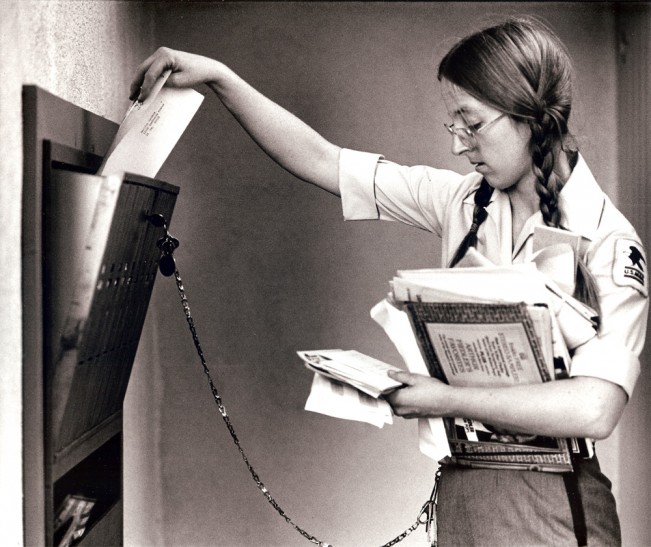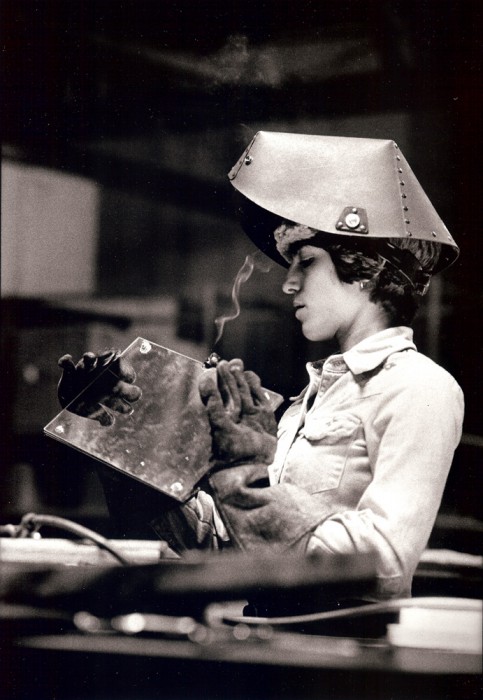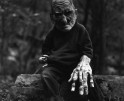Marilyn Sanders: Wo-Men Working
I photograph to share what it is to be alive, an impulse so profound, that I sometimes feel as if images I’m making with my camera could emerge from my inner core as if I were a human camera obscura.– Marilyn Sanders – 2014
Photographer Marilyn Sanders has been interpreting the world for nearly four decades, and today Lenscratch features a series that examines the roles of working women at a time when the Women’s Movement was just taking hold. Marilyn’s focus as a photographer ranges from portraiture, still life, to societal examination. She works with analog and digital processes and her work is produced in silver gelatin and digital prints.
My interest in the visual arts developed out of my training as an actor, and later experience as a producer on documentary films. Colleagues in the acting world who commissioned portraits became my first clients, and photography soon became the focus of my creative and professional life. While in subsequent years I received a wide range of commercial and editorial commissions, I have constantly sought to contribute to our understanding of the significance of the arts in a changing society. My portraits of writers and artists including Bella Lewitzky, Isamu Noguchi, Czeslaw Milosz, Diane Johnson, Wallace Stegner, and Jack Miles are an expression of that commitment.
At the beginning of my career as a photographer, my assignments came from private clients and from corporate clients including Quaker Oats Burry, Children’s Hospital, and Arco. During 1979 and 1980, I began to document the ways in which the roles of women had been affected by the Women’s Movement. I photographed women laboring in nontraditional jobs, as welders, mechanics, and utility workers, and men acting as fully involved parents in raising their children. The result was two portfolios: WO-MEN WORKING and FATHERS. These images were published and acquired by private individuals and by public institutions, including UCLA Special Collections, which established an ongoing permanent collection of my work.
My photographs are in public collections including the National Portrait Gallery at the Smithsonian, the UCLA Clark Memorial Library, UCLA Special Collections, the Bancroft Library at UC Berkeley, Special Collections at Stanford University, the Bibliothèque Nationale, Los Angeles County Museum of Art (the Vernon Collection), the Santa Barbara Museum of Art, and the Los Angeles Central Library. Distinguished private collectors include Alessandro Uzielli, Michael Hawley, Carol Vernon and Robert Turbin.
Wo-Men Working
In 1978, at the beginning of my career as a photographer, I saw the world changing in front of my eyes, and picked up my camera to record it. The project was born one morning when my mail was delivered, not by a mailman as before, but by a female. Astonished, I immediately grabbed my camera and followed her–photographing on the run. Then as I started investigating, I discovered women in other occupations who were also among the first in Los Angeles to seek blue collar jobs previously open only to men. These women wanted the opportunity to earn a living for themselves and their families, and they all strongly desired a greater choice of vocational opportunities. The title photograph is a sign I discovered: the “Wo” had been added by a female employee of the telephone company, who said she was tired of working under a sign that read “MEN.” In 2014 there are many more women driving trucks or fighting fires alongside men, but the issue of “equal pay for equal work” still persists. For that reason I thought to reintroduce these women, who came from widely varied backgrounds, yet all shared a deep commitment to achieving independence. Cathy, who was an Appliance Service representative for the Southern California Gas Co., told me, “I install meters and fix appliances. Now, on every order, we tell the customer how to conserve energy. I get a lot of questions, and it makes me feel good when they say, ‘I didn’t know that.’ I get the impression that if it was a guy they wouldn’t ask.”
The title photograph is a sign I discovered: the “Wo” had been added by a female employee of the telephone company, who said she was tired of working under a sign that read “MEN.” In 2014 there are many more women driving trucks or fighting fires alongside men, but the issue of “equal pay for equal work” still persists. For that reason I thought to reintroduce these women, who came from widely varied backgrounds, yet all shared a deep commitment to achieving independence. Cathy, who was an Appliance Service representative for the Southern California Gas Co., told me, “I install meters and fix appliances. Now, on every order, we tell the customer how to conserve energy. I get a lot of questions, and it makes me feel good when they say, ‘I didn’t know that.’ I get the impression that if it was a guy they wouldn’t ask.” Work, for most of us, is the main driver of our lives. I’d like to acquaint you with these remarkable women who pioneered working in what had always been men’s jobs: digging a hole to root a young tree in ground so rocky it required a ninety-five-pound auger, or being lowered on a safety line into a sewer to solve a drainage problem. Focusing on their spirit and energy, I saw each one meeting new challenges in a calm, unselfconscious way. As the petite welder, Ruth, told me: “I’m learning how to do things I never could before, like picking up twenty feet of steel. I thought it would be too heavy, but you just have to learn to balance it.
Work, for most of us, is the main driver of our lives. I’d like to acquaint you with these remarkable women who pioneered working in what had always been men’s jobs: digging a hole to root a young tree in ground so rocky it required a ninety-five-pound auger, or being lowered on a safety line into a sewer to solve a drainage problem. Focusing on their spirit and energy, I saw each one meeting new challenges in a calm, unselfconscious way. As the petite welder, Ruth, told me: “I’m learning how to do things I never could before, like picking up twenty feet of steel. I thought it would be too heavy, but you just have to learn to balance it.
Posts on Lenscratch may not be reproduced without the permission of the Lenscratch staff and the photographer.
Recommended
-
Martin Stranka: All My StrangersDecember 14th, 2025
-
The Family Album of Ralph Eugene Meatyard at the High MuseumDecember 10th, 2025
-
Paccarik Orue: El MuquiDecember 9th, 2025
-
Richard Renaldi: Billions ServedDecember 6th, 2025
-
The Art of Documentary Photography: Rania MatarOctober 25th, 2025


































































